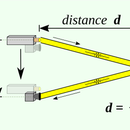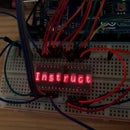Introduction: The Ultimate BLE Presence Detector
Hi there,
In this instructable I will show how I made a really simple Bluetooth Low Energy presence detector, using my smart wristband and a relay I was able to control the ligths of my room;
Everytime I go in, turn the light on and if I left the room or cut the bluetooth connection, the lights turn off.
Step 1: Parts
I'm using a ESP32 Feather but any other will work
1 5v Relay
1 TIP31C Transsitor
1 BLE Server device (Any beacon device)
The TIP31C its ment to control the relay, beacuse the 3V3 digital outputs of the ESP32 are not enough in voltage and current
The relay to control the 120V lights and the wristband to detect the presence of the person.
Step 2: Circuit
This is really simple, the pin number 33 of the ESP32 goes to the base of the transistor, with this we can add the 5V VCC signal and control a bigger voltage with the 3V3 voltage output, then, with the relay we can controll then the 120V of the light.
Step 3: Code
#include "BLEDevice.h"
int Lampara = 33; int Contador = 0;
static BLEAddress *pServerAddress; BLEScan* pBLEScan; BLEClient* pClient; bool deviceFound = false; bool Encendida = false; bool BotonOff = false;
String knownAddresses[] = { "your:device:mac:address"};
unsigned long entry;static void notifyCallback(
BLERemoteCharacteristic* pBLERemoteCharacteristic,
uint8_t* pData,
size_t length,
bool isNotify) {
Serial.print("Notify callback for characteristic ");
Serial.print(pBLERemoteCharacteristic->getUUID().toString().c_str());
Serial.print(" of data length ");
Serial.println(length);
}class MyAdvertisedDeviceCallbacks: public BLEAdvertisedDeviceCallbacks {
void onResult(BLEAdvertisedDevice Device){
//Serial.print("BLE Advertised Device found: ");
//Serial.println(Device.toString().c_str());
pServerAddress = new BLEAddress(Device.getAddress());
bool known = false;
bool Master = false;
for (int i = 0; i < (sizeof(knownAddresses) / sizeof(knownAddresses[0])); i++) {
if (strcmp(pServerAddress->toString().c_str(), knownAddresses[i].c_str()) == 0)
known = true;
}
if (known) {
Serial.print("Device found: ");
Serial.println(Device.getRSSI());
if (Device.getRSSI() > -85) {
deviceFound = true;
}
else {
deviceFound = false;
}
Device.getScan()->stop();
delay(100);
}
}
};void setup() {
Serial.begin(115200);
pinMode(Lampara,OUTPUT);
digitalWrite(Lampara,LOW);
BLEDevice::init("");
pClient = BLEDevice::createClient();
pBLEScan = BLEDevice::getScan();
pBLEScan->setAdvertisedDeviceCallbacks(new MyAdvertisedDeviceCallbacks());
pBLEScan->setActiveScan(true);
Serial.println("Done");
}void Bluetooth() {
Serial.println();
Serial.println("BLE Scan restarted.....");
deviceFound = false;
BLEScanResults scanResults = pBLEScan->start(5);
if (deviceFound) {
Serial.println("Encender Lamara");
Encendida = true;
digitalWrite(Lampara,HIGH);
Contador = 0;
delay(10000);
}
else{
digitalWrite(Lampara,LOW);
delay(1000);
}
}void loop() {
Bluetooth();
}Step 4: PCB for Light Control
I made this circtuit on a protoype pcb to make things cleaner.
Step 5: Done
And you are done!
You can use this code to open doors instead, or to control different things
I hope you like my instructable, and if you have any question make me a comment or send me an inbox, I'll be happy to answer





